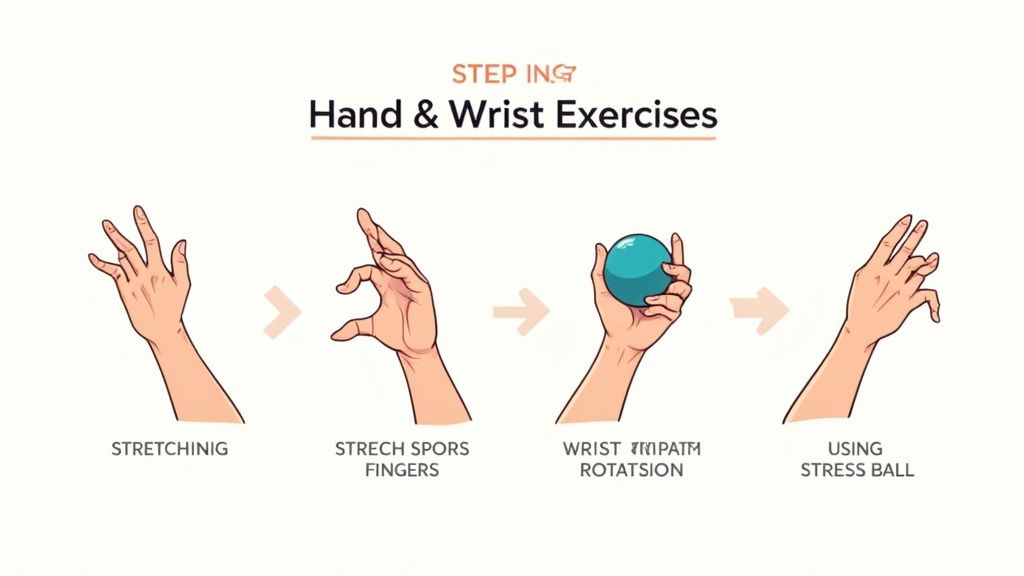The Ultimate Guide to Preventing Repetitive Strain Injury: Evidence-Based Strategies That Actually Work
Understanding the Real Impact of Repetitive Strain Injuries

The impact of repetitive strain injuries (RSIs) extends far beyond occasional discomfort. These injuries can profoundly affect both your work and personal life in ways many don't fully grasp until they experience them firsthand. Think about a musician who can no longer perform due to wrist pain, or a writer who struggles to hold a pen - these real examples show just how deeply RSIs can disrupt careers and daily activities. Understanding these impacts is essential for taking prevention seriously.
Beyond the Physical: The Hidden Costs of RSIs
While medical expenses often come to mind first when thinking about RSI costs, the true price tag includes much more. Lost work time, reduced earning potential, and ongoing pain management create significant financial strain. The emotional toll can be just as heavy - chronic pain often leads to frustration and feelings of helplessness that affect relationships and overall quality of life.
Daily activities that most take for granted can become major challenges. Simple tasks like cooking dinner, doing laundry, or playing with children grow difficult or impossible. This loss of independence creates ripple effects throughout your life, impacting not just you but your entire family. The strain on relationships and mental health often proves as challenging as the physical symptoms themselves.
Missed Signals and Misguided Advice: Common Pitfalls
One dangerous mistake is brushing off early RSI warning signs as normal muscle fatigue. Those initial tingles, numbness, and occasional aches aren't just minor annoyances - they're your body's way of flagging potential problems. Ignoring these signals allows the condition to worsen silently until more serious symptoms develop.
Standard RSI prevention advice often misses the mark too. Basic recommendations like "take regular breaks" or "buy an ergonomic mouse" only scratch the surface. While breaks matter, they don't address core issues like poor posture habits or repetitive movement patterns that contribute to injury. Each person's situation requires an individual assessment of risk factors and targeted solutions.
The Path Forward: A Proactive Approach
Preventing RSIs demands shifting from reaction to prevention. This means carefully evaluating your personal risk factors, setting up proper ergonomics for your specific needs, and building regular movement into your daily routine. Just as a well-built foundation protects a building, taking these preventive steps helps your body handle ongoing physical demands safely. With a strategic approach focused on your individual circumstances, you can develop sustainable work habits that protect your long-term health and function.
Building Your Ergonomic Safe Haven

Preventing repetitive strain injury (RSI) starts with creating a workspace that works with your body instead of against it. You don't need expensive gadgets - just thoughtful adjustments based on how you naturally move and work. Understanding your body's needs is the foundation for building a comfortable workspace that helps prevent injury.
Assessing Your Current Setup: A Critical First Step
Before buying any new equipment, examine how your current workspace affects your body. Do you notice wrist pain from typing? Is your neck strained from looking down at your screen? Small discomforts that seem minor now can develop into bigger problems over time. For instance, using a chair without proper back support often leads to lower back issues. The same goes for keyboard placement - having it too high strains your shoulders and wrists, putting you at risk for RSI.
Making Smart Investments: Prioritizing What Matters
While many products claim to be "ergonomic," quality and effectiveness vary widely. Some poorly designed items can actually make existing problems worse. Focus on core essentials that will make a real difference. Start with a good chair that adjusts properly and supports your back. Add a monitor arm so you can position your screen at eye level to protect your neck. These fundamental improvements do more for your health than chasing the latest ergonomic trends.
Tailoring Your Setup for Different Work Environments
Creating an RSI-preventing workspace matters whether you're in an office or working remotely. Office workers should work with facilities staff to adjust desk and chair heights properly. Remote workers need to take charge of optimizing their home setup. For example, using a laptop stand with external keyboard and mouse helps prevent hunching and wrist strain when working on a laptop. But equipment alone isn't enough - remember to move and take breaks regularly, even with perfect ergonomics.
Budget-Friendly Solutions for Ergonomic Improvement
You can make meaningful ergonomic improvements without spending a lot. Simple fixes often work well - like using a rolled towel for lumbar support until you can get an ergonomic chair. Or raising your monitor with books to reduce neck strain. These small tweaks may seem basic but can significantly impact comfort and help prevent RSI. Free online resources like ergonomic assessment tools and exercise guides provide personalized tips for optimizing your workspace and moving more throughout the day. With some creativity, you can build a healthier workspace on any budget.
Movement Strategies That Actually Work

A good ergonomic setup helps prevent repetitive strain injury (RSI), but it's only part of the solution. Your body needs regular movement to stay healthy - much like a car needs to be driven regularly to keep running smoothly. This section shows you practical ways to add effective movement into your workday, turning short breaks into opportunities for better health.
Targeted Exercises: Strengthening Vulnerable Areas
The wrists, forearms, neck and shoulders are most at risk for RSI during computer work. Building strength in these areas helps protect them from injury - similar to reinforcing weak spots in a building. You don't need long workout sessions. Simple exercises done regularly make a real difference. For example, doing wrist curls and extensions with light weights helps build wrist stability and prevent carpal tunnel syndrome. Taking a few minutes for neck stretches and shoulder rolls relieves tension and keeps these areas mobile and pain-free.
Micro-Breaks: Maximizing Short Bursts of Movement
Taking quick 1-2 minute movement breaks throughout your day is key for preventing RSI. These brief activity bursts break up long periods of sitting and get your blood flowing. This is especially important since 9% of U.S. adults reported RSIs in 2021. Think of micro-breaks like hitting refresh on your body - a quick reset that prevents stiffness and pain. Simple actions like walking to get water, stretching at your desk, or standing up to move around reduce muscle fatigue and improve circulation - two critical factors in RSI prevention.
Structured Movement Breaks: Energizing Your Workflow
Beyond quick micro-breaks, taking longer 5-10 minute movement breaks each hour provides even more benefits for preventing RSI. Use this time for focused exercises and stretches. A short yoga sequence or some basic bodyweight movements not only prevents injury but also boosts your energy and mental focus. Apps like Moova offer guided routines and scheduling help to make movement breaks a natural part of your day. These breaks give both your body and mind a chance to reset, reducing stress while protecting against RSI.
Modifying for Different Needs: Personalized Movement
Just as everyone's body is different, your movement routine should fit your specific situation. Consider your fitness level, any existing health conditions, and your workspace when choosing exercises. If mobility is limited, try chair-based movements to improve blood flow and build strength. In a shared office, find quiet spots for stretching or do subtle desk exercises that won't disturb others. Making your movement strategy work for your needs ensures you'll stick with it long-term to prevent RSI.
Mastering Daily Work Habits for Long-Term Prevention

While setting up an ergonomic workspace and taking regular movement breaks are essential first steps, preventing repetitive strain injury (RSI) requires rethinking how you approach your daily work. This means being mindful of your task patterns, timing, and body signals throughout each day.
Task Rotation and Work Pacing: Breaking the Repetition Cycle
One key way to prevent RSI is mixing up your activities during the workday. Think of it like rotating crops in a garden - when you alternate between different types of work, you avoid overusing the same muscle groups. For example, you might switch between computer tasks, phone calls, and paperwork that each use different movements. Breaking larger projects into smaller chunks also helps by creating natural pauses that give your body brief recovery periods.
Micro-Breaks: Small Changes, Big Impact
Taking micro-breaks of just 1-2 minutes provides major benefits for preventing RSI. These quick pauses help your muscles recover and improve blood flow. Simple actions like standing up to stretch, gently rolling your wrists, or looking away from your screen make a real difference. Micro-breaks can even boost your focus and output. According to recent data, implementing regular micro-breaks could help reduce the 9% RSI rate currently seen among U.S. adults.
Recognizing and Modifying Harmful Movement Patterns
Being aware of how you move is crucial for RSI prevention. Pay attention to recurring aches or discomfort, as these often signal potential issues early on. For instance, if you notice shoulder tension while typing, you may need to adjust your posture or keyboard setup. Look at how you perform common tasks too - are you lifting things properly or holding your phone in ways that strain your neck? Small tweaks to these everyday movements add up. Apps like Moova can help by providing timely reminders and exercises to keep you moving well. By combining movement awareness with proactive work habits, you'll build lasting protection against RSI while maintaining your physical wellbeing.
Navigating the World of Ergonomic Tools
Creating a workspace that prevents repetitive strain injury (RSI) requires more than just good posture and regular breaks. The right ergonomic tools play a vital role, but with countless products claiming ergonomic benefits, finding truly effective options can be challenging. This guide will help you evaluate ergonomic products and choose tools that genuinely support your needs.
Evaluating Ergonomic Products: Beyond the Buzzwords
When assessing ergonomic products, it's essential to look past marketing claims and focus on how they address your specific RSI risk factors. For example, while a vertical mouse might help someone with wrist pain, it could be unsuitable for someone experiencing shoulder discomfort. Consider which movements cause you strain and evaluate products based on how they accommodate your particular needs.
Pay close attention to user reviews discussing long-term experiences and potential drawbacks, since many ergonomic adjustments require an adaptation period. These real-world perspectives can help you avoid investing in tools that don't deliver lasting benefits.
Essential Ergonomic Tools and Accessories
Several key categories of ergonomic tools can help prevent RSI:
- Input Devices: Since keyboards and mice often contribute to RSI, look for ergonomic keyboards with split designs, angled keys, and wrist support to maintain neutral positions. Ergonomic mice come in various shapes designed to minimize strain on your wrist and forearm.
- Monitor Arms and Stands: Position your screen at eye level to reduce neck and shoulder strain. Adjustable monitor arms let you customize height and tilt, which is especially helpful when using multiple screens or frequently changing viewing angles.
- Chairs: A well-designed chair forms the foundation of an ergonomic setup. Look for adjustable features like lumbar support, armrests, and seat height to fit your body type. These customization options help maintain proper spine alignment and prevent pressure points.
- Workstation Accessories: Simple additions like document holders, footrests, and anti-glare filters can improve comfort and efficiency. These accessories help maintain good posture and reduce eye strain while supporting healthy work habits.
Implementing New Tools: A Gradual Approach
When introducing new ergonomic tools, take a measured approach since your body needs time to adapt to different postures and movements. Start by using new items for short periods - perhaps an hour or two daily with a new keyboard - then gradually increase duration as you adjust. This careful progression helps prevent discomfort while allowing your body to acclimate effectively.
Remember that proper usage techniques matter just as much as the tools themselves. Consult product guides and ergonomic resources for setup instructions. Even the best ergonomic equipment works best when combined with regular movement breaks and mindful work habits. By integrating proper tools, techniques, and healthy practices, you create an environment that supports long-term musculoskeletal health.
Creating Your Personal Prevention Strategy
Preventing repetitive strain injury requires an individual approach that fits your specific work habits and needs. Like a well-fitting suit, your prevention plan should address the unique ways you use your body throughout the day. Here's how to build an effective strategy that supports both your comfort and productivity for the long term.
Understanding Your Body's Signals: Early Detection is Key
Learning to listen to your body's warning signs is essential for preventing RSI. Small signals like tingling, numbness, or minor aches may seem unimportant at first, but they can point to developing problems. For instance, a slight wrist discomfort while typing might not grab your attention initially, but addressing it early can help prevent serious conditions like carpal tunnel syndrome. Paying attention to these physical cues and taking action right away is crucial to avoid chronic issues.
Building a Sustainable Routine: Consistency Over Intensity
The most effective prevention routines involve making small, manageable changes to your daily work habits. Rather than trying to change everything at once, focus on incorporating one adjustment at a time - like taking short movement breaks each hour, tweaking your workspace setup, or modifying how you perform repetitive tasks. Tools like the Moova app can help by providing break reminders and guided exercises. Think of prevention as a steady marathon rather than an intense sprint - small, regular efforts create lasting positive change.
Self-Monitoring and Seeking Professional Help: Knowing When to Act
Keep track of how your body feels by maintaining a simple journal of any recurring discomfort. Note when pain occurs, what you were doing, and potential triggers. This helps identify patterns - for example, your notes might reveal neck pain consistently follows long video meetings, pointing to a need for monitor height adjustments or neck stretching breaks. While self-monitoring is valuable, don't hesitate to consult healthcare providers or ergonomics experts if you experience ongoing pain or worsening symptoms. They can assess your situation and recommend specific solutions.
Adapting Your Strategy Over Time: A Dynamic Approach
Your prevention plan needs to evolve as your work and physical needs change. Just as you'd adjust your garden care with the seasons, modify your RSI prevention routine based on changes in your work environment, job responsibilities, or physical condition. For example, switching to remote work might require rethinking your workspace setup and movement patterns. Stay flexible and willing to adjust your approach to maintain its effectiveness.
Are you ready to protect yourself from RSI and create healthier work habits? Download the Moova app today to start building regular movement breaks into your routine!







